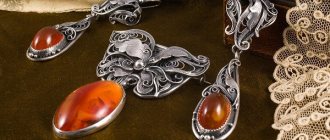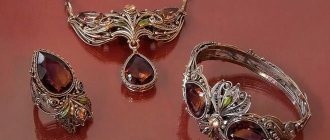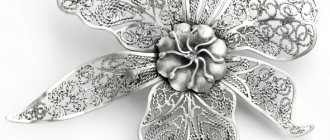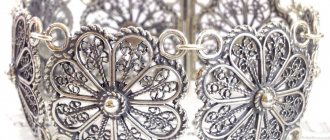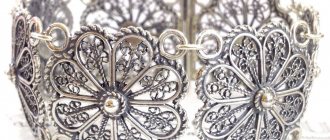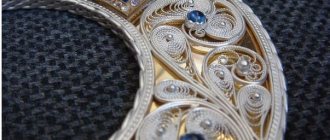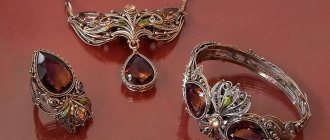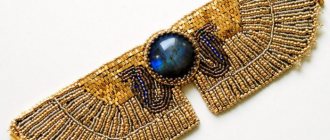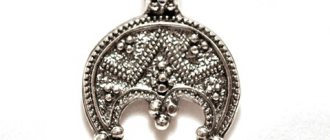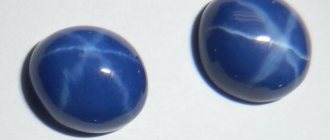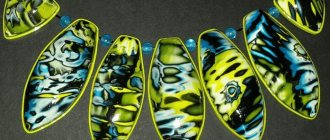Almost everyone is familiar with the expression “filigree work,” but few have any idea of its origin. Filigree is a type of jewelry craftsmanship, the finest interweaving of silver threads from which real masterpieces are created.
The technique is well known to the masters of yesteryear, who created products that have survived to this day.
Filigree and filigree
The only differences are in the origin of the words; they denote one type of jewelry art. The name “scan” comes from the Old Russian word “skat”, meaning “to twist”, “to twist”, which accurately reflects the essence of the work.
The word “filigree” comes from Latin words that are translated as “grain”, “thread”.
Interesting! Jewelry art was actively used all over the world. In famous museums you can find filigree jewelry dating back to the 6th century BC.
Who owns the filigree technique: historical background
It is believed that the first masters who mastered this interesting technique appeared in Ancient Egypt and ancient Greece. The oldest items discovered during excavations of ancient cities date back to the 6th century BC.
The rapid growth in popularity of filigree products was noted in the 18th century.
European craftsmen created unique jewelry for wealthy citizens and nobles. The 19th century is rightfully considered the heyday of filigree crafts. At this time, jewelry began to be mass produced and was available to almost all classes.
Russian filigree originates in ancient centuries. Filigree in Ancient Rus' was primarily a ritual item, which then migrated to the princesses’ boxes.
The famous Krasnoselskaya filigree created a worldwide sensation at the Paris Exhibition in 1937. Success was repeated 2 years later in New York.
Types of jewelry filigree
Depending on the technique used to create the work of art, there are several types of filigree.
Brazed filigree
This type of filigree was popular in medieval Europe. The method involves soldering a silver thread onto a previously prepared metal plate.
If the plate remains in the finished product, then this type is called background or “blank”. In some cases, the background is sawed out, resulting in a cut-out filigree.
Openwork filigree
The main feature of openwork filigree is the absence of a background. A pattern is assembled from silver threads soldered together. The grain is soldered onto the wire. If it is not in the product, then it is called flat lace.
Two- and three-dimensional volumetric filigree patterns are called sculptural-relief filigree.
Volumetric filigree
Separately, we should highlight products made using the volumetric filigree technique. Often, such filigree takes the form of household items, dishes, figurines of birds and animals.
Due to the increased complexity of the product, individual filigree elements are first created, which are then combined into one whole.
Interesting! In jewelry production, you can find all three filigree techniques, depending on the type of product.
How jewelry grain is made
Scientists believe that the methods of making grain have not changed over the centuries. The craftsmen knew several methods of creating it.
One of them is to pass a stream of molten gold or silver into the water through a filter. The result is a grain that is heterogeneous in shape and diameter.
When grain is produced from blanks of any kind (pieces, rings, grains), then these metal parts are straightened in powder obtained from charcoal. The result is standard size balls.
How filigree jewelry is made
Filigree combines several basic elements that make up the finished pattern - rope, lace, herringbone, wicker, track. Sometimes grains - small metal balls - are added to jewelry.
They are soldered onto the surface of the main pattern, repeating it. Such decorations look unusual and elegant.
Silver is often used to make filigree items. You can find jewelry made of gold, brass, cupronickel, and copper.
Jewelry of any complexity is created using the filigree technique. The final cost depends not only on the material used, but also on the complexity of the technology.
Silver filigree: manufacturing technology
In ancient times, a jewelry master was engaged in the manufacture of filigree from the development of a sketch to the final polishing of the product.
Today, large productions divide the work into stages, so a whole team of specialists is involved in the manufacture of one piece of jewelry. Private jewelers still make their own filigree. Schemes of patterns and motifs are passed on from master to student.
Production begins with the production of thin metal wire. To do this, a solid silver bar is heated, softened, and then drawn out. Rolls out to the desired length and thickness.
The rock patterns are assembled from individual elements, so the next stage is their manufacture. A thin wire is bent using special tweezers - a forceps.
The finished parts are applied to paper with a pre-drawn drawing of the product. If all the elements are assembled, then the master starts soldering. The openwork elements are securely fastened together, forming a single whole.
A well-made product is durable, despite its external tenderness and airiness.
The final stage of production is rhodium plating of silver jewelry and silver plating of metal jewelry (pure 999.99 silver is used for this). In some cases, artificial aging is performed by oxidizing the metal.
Materials and tools for work
For jute filigree you will need:
- jute;
- glue;
- scissors;
- tweezers;
- toothpicks or wooden kebab sticks;
- stationery knife;
- tablet;
- various decor in the form of pebbles, beads, beads, buttons, etc.;
- varnish
Jute
This is the most important material to work with. It is a flax thread, which is intended for use in everyday life or in construction, so you can purchase jute at any repair or hardware store.
The thread is grayish in color, twisted from several fibers, a little shaggy. This material easily takes different shapes, can be painted, and becomes rigid.
The twine differs in diameter; for filigree, you should choose a twist of two threads. Preference should be given to rope in spools rather than balls. This is due to the quality of the threads and winding.
Before work, it is recommended to wash the material; this will help to avoid a gray coating on your hands and wash away all foreign particles in the form of sticks and grains.
And the rope itself will become round and will fray less, making it more convenient to work. To do this, the twine is wound into skeins, placed in a solution with powder for 1-2 hours, then you can rub it a little, take it out and hang it to dry.
The cord can be colored using acrylic paints or bleach. You can also dilute food coloring in hot water with a spoonful of vinegar, dip the jute in it, and leave it for several hours. After some time, the thread will be the color you need.
Glue
Experienced needlewomen prefer glue like Titan. It is a clear, thick liquid with a pungent odor. When hardened, it becomes invisible, can be applied easily, dries quickly, and spreads perfectly on film and other surfaces.
But in order to clean your hands later without problems, you need to lubricate them thickly with cream or quickly wash your hands with hot water before the glue hardens.
Scissors
The cutting tool must work well and be sharp. Suitable for manicure. Will be needed when removing glue at the final stage.
Tweezers
The device helps in forming a pattern; it can be used to correct something when it is shifted or to lay out small parts of a craft.
Skewers, toothpicks
Use a toothpick to straighten the patterns if they moved during laying out. Skewers are needed to create additional parts such as legs and others. They are sold in any household store.
Stationery knife
This tool is used to trim excess, remove glue and base. Should be quite sharp. Every store has stationery.
tablet
Often used instead of a press. Maybe small. Sometimes you will need several pieces. If not, you can use old shelves cut to size or ask your friends.
Decor
As decoration, they use everything that is at hand or in the nearest retail chains. These are beads, marbles, buttons, shells, rhinestones.
You can take apart old beads, if any. Glass pebbles may be found in pet stores. Rhinestones, buttons, beads in retail chains for handicrafts.
Varnish
Necessary for the final stage of manufacturing. They cover the product so that it does not lose its appearance, does not get wet, and acquires rigidity. Acrylic varnish is mainly used, but can be replaced with PVA glue.
The history of the heyday of filigree
The growing popularity of unusual technology begins in the 17th century. Masterpieces are created that compete with crystal vases, figurines, and household items.
Production technology is becoming more complex: techniques are used to combine metal filigree patterns with enamel, crystal, mother-of-pearl, and semi-precious stones.
The decline in the popularity of jewelry began during the First World War.
Kazakovskaya filigree – modern production
To this day, the Kazakovsky Art Products Enterprise has been developing and producing unique works of art. Kazakovsky filigree is distinguished by its openwork and airiness.
View this post on Instagram
Posted by Russian Souvenirs Store (@russiangifts) Jan 31, 2018 at 7:51 PST
Design artists spend a lot of time working on every detail so that the product looks harmonious using classical technology.
Interesting! Filigree may seem old-fashioned, but it is not. The company keeps up with the times, offering interesting solutions - devices for consuming tobacco, alcohol, cases for flash cards, trays, and interior figurines.
Filigree from "Kubachi"
The Kubachi jewelry factory launched its production in the village of the same name. The products are known throughout the country. The uniqueness of the jewelry lies in the combination of classical filigree techniques with embossing, engraving, and Dagestan blackening.
View this post on Instagram
Posted by Murad (@murad_yusbashev) Jan 22, 2022 at 9:43 PST
The result is completely non-trivial things.
Products with filigree elements versus true filigree
Certain elements of scanned technology are widely used to make jewelry. For example, grains can often be found in rings and earrings. Combining techniques makes it possible to get an interesting result.
Classic filigree is too pretentious for everyday wear. The buyer will prefer a simpler product, but with filigree elements.
Kazakovskaya filigree. Slavic art
One of the oldest types of artistic metal processing is filigree (from Old Russian - to twist), or, as this type of jewelry technique is also called - filigree (from the Italian filigrana, in turn this word comes from the Latin words filum (thread) and granum (grain) , since the pattern is sometimes made not only from twisted wire, but from tiny metal balls).
Filigree can be called the apotheosis of ancient jewelry art, which has survived and exists in our time, being a kind of Russian symbol. Filigree is the making of jewelry using a special method. For this purpose, a method of twisting the thinnest wire made of precious metals (gold or silver) is used. The whole work comes down to manipulating gold thread: by twisting two wires, an openwork pattern of extraordinary beauty is obtained, which is then applied to the surface of the jewelry and soldered to it. This is quite painstaking and time-consuming work, since the jewelry maker has to process the entire surface of the jewelry in this way. The partial filigree method is also used when it is necessary to mask the joints of pieces of jewelry soldered to each other. Earrings, rings, and pendants are also processed with filigree, which make a great gift for a woman or man. Silver filigree is mostly common - silver jewelry is especially impressive and beautiful. Together with the filigree technique, filigree or granulation techniques are also used. These two methods are inseparable from each other - together they create an amazing impression of harmony. Filigree are miniature balls or grains of precious metal, soldered to the surface of the jewelry and forming a unique pattern. This method is very often used by jewelers, since filigree or granulation is very expressive and gives the product aesthetic power.
In Rus', filigree has been known for a very long time. Filigree items are found in excavations of burial mounds from the 9th century . Products of Kievan Rus were made using the graining technique back in the 10th century. In these things, twisted wire was almost never used. But already from the 12th century. grain fades into the background and soldered background filigree is increasingly used. From the 13th century the number of types of filigree is increasing - openwork and relief filigree are used. Stones are beginning to play an increasingly important role, and multifaceted solutions are emerging. Filigree items were produced in royal or monastic workshops. Master scanners conceived the products and carried out all operations for their production. In the 17th century The need for scanned items is increasing. A division of labor appears, artisans become independent, individual craftsmen produce wire and scanned elements. In the 18th century Large filigree items were made; along with stones, crystal and mother-of-pearl were widely used. At the same time, small silver items became widespread: vases, salt shakers, and boxes. Since the 19th century filigree products were already produced by factories in large quantities. They are diverse both in purpose and in assortment; expensive dishes, church utensils, toilet accessories. Technological techniques reach high perfection. Relief openwork filigree blossoms, translucent (window) enamel appears. In Russia, the village of Kazakovo in the Vachsky district of the Nizhny Novgorod region is becoming one of the largest centers of scanned production. The first Kazakovsky artel for the production of filigree items was formed in 1939. And during the Great Patriotic War, the artel did not stop its work: they wove officer shoulder straps, made stars for them, and made cigarette cases. In the post-war period, they mastered knife and fork production.
Information In 1927, a metal industry was founded in Kazakovo.
In 1939, twelve artel workers of the Kazakovskaya metal artel under the leadership of O.I. Tarakanova assembled their first filigree glass holder. The successor to the traditions and skills of the Kazakovsky artel was the Kazakovsky Art Products Enterprise CJSC (KPHI). The company inherits and develops the richest traditions of the past, seeks and develops new types of products. When composing a pattern, artists monitor not only the proportionality of its individual parts, the smoothness and beauty of the curves of large and small elements, but also the pattern of the gaps, since it plays a big role in constructing the pattern. Being in constant creative search, artists find new motifs and combinations. This is how they came to the use of gilding, the inclusion of natural stones, crystal, bone, and enamel in the design. The Kazakovsky plant produces a wide variety of artistic products: decorative vases and bowls, music boxes, glass holders, vases, candy bowls, women's jewelry, teaspoons, cups, medals, badges, orders and insignia for the Russian army. In recent years, the company began to produce church items - table and hanging lamps, icon frames, crosses, panagias. CJSC "KPHI" cooperates with the Holy Trinity, Seraphim-Diveevsky and St. Danilovsky monasteries, the Trinity-Sergius Lavra, Alexander Nevsky Cathedral, and churches of St. Petersburg. In addition, the company produces filigree products with heraldry and symbols of both government agencies and private companies. Since 1998, the company received the right to work with the mark of the Patriarchal Workshops with the blessing of the Patriarch of All Rus'. The products of the masters are exhibited at all-Russian exhibitions and have been awarded many awards.
Features of filigree In the mid-1950s, characteristic features characteristic only of Cossack filigree developed. A special feature of Cossack products is the independent significance of filigree: it is not used as part of the decoration of a metal object, as an overlay on metal, but entirely openwork products are created from filigree. Decorative panels and plates, vases and candy bowls, glass holders, boxes, various souvenirs, badges and medals - all these products are made entirely by hand. The filigree pattern is made from smooth or twisted copper wire according to a preliminary drawing on paper, to which individual details of the filigree ornament are glued. Then the future product is sprinkled with silver solder and soldered. When soldering, the paper burns, and the openwork curls are soldered together, forming a durable patterned lace. Further processing is silver plating with anode silver 999.9. An oxide film is applied to give the color of antique silver. Elements of a filigree pattern can be very diverse: in the form of a rope, lace, weaving, herringbone, path, satin stitch, etc.
Filigree is often combined with grains, which are small metal balls that are soldered into pre-prepared cells (recesses). The grain creates a spectacular texture and play of light and shade, thanks to which the products acquire a particularly elegant, sophisticated look. The materials for filigree products are alloys of gold, silver and platinum, as well as copper, brass, cupronickel, and nickel silver. Filigree is often combined with enamel (including enamel), engraving, and embossing. The filigree technique can be used to make all types of jewelry without exception. Fishing technology
Materials, tools Filigree continues to be a manual production - this is its characteristic feature. The technological process of filigree manufacturing is divided into preparatory operations: preparation of templates, filigree, its setting, soldering, mounting, surface finishing, each of which is performed by a master of a certain qualification. Preparatory operations The development of templates consists of dividing the product design into parts, each of which is unfolded on a plane. The elements that make up the drawing are clarified and classified. The types of filigree are established: twisted, smooth, thick or thin, flattened or round. If the pattern is too complex, it is divided into simple elements. Working with individual short sections and simple, albeit many, curls is much easier than with one, but several times bent wire. With high-quality soldering, the joints of the scanners are almost invisible. Filigree is made from pure metals - gold, silver, copper, which have good toughness, softness, and ductility. These qualities ensure wire drawing and rolling, its twisting and filigree set. Their melting point is quite high, which is convenient for soldering. As an exception, you can use alloys (for example, 916 silver) for large structural parts of filigree and for the production of grain. To select the wire for filigree of the required cross-section, it is passed through a selected die (ceisan) - a hole in the drawing board - a plate made of hard grade steel. Pulling is carried out without heating the wire, but during the process it becomes hard and therefore needs to be periodically annealed to restore softness. A drawing board with a series of successively smaller holes is strengthened in a vice, the end of the wire is sharpened with a file, threaded through the hole, and the entire wire is pulled smoothly using pliers. To reduce friction, the holes of the drawing board or the wire are lubricated with some kind of oil. By stretching the wire through a series of successively smaller holes, you can obtain the desired cross-section. Roll the wire into a skein, anneal it, bleach it in a weak (5%) solution of sulfuric acid and rinse well in running water.
Making filigree and grain You can roll (knit) filigree on the spindle of an electric motor, drill, or by hanging a rotating weight at the end of the wire. Twisting is done in two steps, between which the wire is annealed, restoring its softness. The rolled filigree is passed through flat rollers, flattened and annealed. The rolling can be strong, it can be almost invisible - it depends on the artist’s intention. The twisted filigree can also be left in the form of a cord, completely unflattened, and can consist of 3-4 wires. The cord can be made from wires of different thicknesses or from several already twisted wires, going in opposite directions. The filigree, woven like a braid from several wires by hand, gives the design great originality. Another type of filigree is a thin wire wound tightly onto a thick one, like a guitar string. A thin smooth wire can also be passed into a groove formed by two thick twisted wires. Items made using the filigree technique almost always include graining, which is a special accent in filigree lace. To ensure that the grains are the same, you need pieces of wire of equal size. To do this, a thin wire is wound in tight turns around an iron rod, removed from it and cut into separate rings. The rings can be laid out on charcoal or asbestos and melted. To obtain a flat base of the balls, mica should be placed. A set of filigree is divided into two operations: bending the details of the design and installing, fitting, gluing them in place. It’s more rational to prepare all the elements of the drawing and only then fix them in place. The elements are bent using tweezers - a forceps. The ends of these tweezers are pointed and allow you to capture the thinnest scans. The bending is done with the right hand, while the index finger of the left holds the end of the wire. The entire operation takes place on a flat zinc or aluminum plate.
Typesetting methods There are several ways of typing scans. Soldered filigree is used for flat products. The base is a thin sheet of silver or copper. The drawing is typed starting from the main structural details of the composition. These can be the contours of the design, the central rosette and its divisions, the places where the stones are attached. The pattern is filled with filigree details made from thinner wire and then the thinnest elements of the design, its filling. The last stage is grain placement. The filigree is glued with wood glue, cherry glue, BF-2 or nitro varnish. During the set process, it is necessary to ensure that all elements of the set fit tightly to each other along the entire length of their base. This will save you from repeated soldering, burning of parts, roughly soldered areas, and reworking of the rock surface. To accurately ensure the location of the grain, you should plant it in a ring, a curl of a skaninka or a special nest - a hole made by a canfarnik. This increases the soldering area and the strength of grain attachment. In cases where rings are not used, hemispherical grains made on mica are used. If the grains are located one after another, like a string of pearls, they can be collected between two thin wires running parallel.
Volumetric products A set of filigree for volumetric (with a background) products is made on pre-chased, extruded or stamped forms. This type of set is more complex than the previous one, because the scanner, in addition to its design, also bends according to the intended shape. If the shape is simpler, for example a cylinder or a cone, then the filigree can be typed and soldered on a plane, in a development, and then bent. On a more complex form, this will lead to deformation of the design, so the set should be done immediately on the required form. In this case, you also need to ensure that the entire surface of the scanner fits tightly to the form. Flat openwork filigree using wood glue, BF-2 or nitro varnish is typed onto thin smooth paper like sheet metal. The fit and strength of the set in this case is especially important, since the background will no longer support it. If the set is not tight, individual parts will fall out, which will complicate the soldering process. Volumetric openwork filigree is typed onto embossed or pressed templates - forms made of ordinary roofing iron. Everything here is produced with the same consistency as in openwork brazed filigree. The difference is that filigree can be easily removed from low-carbon iron. But at the same time, there should be no soldered seams on the iron that could separate when heated. Openwork volumetric products can also be made using the beating method. If the assembled filigree is well soldered, it can be easily knocked out and can be given any shape. The volumetric form is made from several or even two parts, which are then soldered together. It must be taken into account, however, that some parts are pulled out when punched out and distortion occurs. To avoid this, you need to give the necessary allowances when developing the drawing. When soldering, a frame is soldered to large volumetric filigree items on the inside for strength, or parts of the product are soldered separately and then mounted and soldered to the frame.
Soldering filigree When soldering, filigree assembled with wood glue must be tied with thin soft iron wire - bindra. This is done because when burned, wood glue swells and moves filigree parts that are not fastened together. If the filigree is set on nitro varnish or BF-2 glue, it is not necessary to tie it, since these substances burn out before the scanners have time to move. However, bulky items should be tied with a binder so that each scan is pressed. Openwork filigree typed on paper must be placed on a soft iron plate, previously rubbed with chalk (so that the filigree does not become soldered to it). For soldering copper products, solder is prepared from one part copper and two parts 875 silver. A silver product is soldered with solder from one part pure copper and four parts 875-grade silver. It is most convenient to use solder in the form of sawdust. To do this, clamp the ingot in a vice and file it down. Iron pieces that get into the solder (from a file or saw) should be removed with a magnet, otherwise they will oxidize and subsequently spoil the surface of the product when bleached. The flux used for soldering is borax. Pre-burnt (so that it does not swell during soldering) and crushed borax is mixed with solder (1:1). The soldering areas are moistened with a weak borax solution and sprinkled with the prepared mixture, which prevents the appearance of unsoldered areas and the filling of small filigree parts with solder. Soldering is done with a low flame. Kerosene, gasoline and gas can be used as fuel. For soldering with kerosene, a special lamp and heater are used, and for soldering with gasoline, a soldering apparatus is used; with gas, a special burner and heater are used. The flame should not be sharp and narrow (so as not to burn the product). For soldering filigree, you cannot use jewelry solders containing zinc, since during repeated soldering it burns out the shells and dissolves thin scans. However, if for any reason part of the pattern is damaged, it can be cut out, a new one made and soldered again. After soldering is completed, the item is thoroughly bleached in a 5% sulfuric acid solution so that the remains of glassy borax cannot interfere with subsequent finishing. The listed types of techniques for making filigree products are in turn divided into varieties, each of which has its own name. Soldered filigree can be: background - when a filigree pattern is soldered onto sheet material. In this case, the background may be shot, i.e. enrich yourself in texture; perforated or sawn - when after soldering, sections of the background are cut down or sawed out; relief - a filigree pattern is soldered onto a chased or stamped relief.
Openwork filigree also has varieties: flat openwork filigree - when the product has the appearance of lace, consisting of wire elements welded together; sculptural-relief openwork filigree - a three-dimensional relief or high relief formed by openwork filigree; multilayer filigree - when the pattern consists of several layers of filigree and the bottom one is like a background. This solution is approaching a sculptural one. The 3D filigree technique is often used to make dishes and toiletries. These are dishes, boxes, vases, caskets. Several types of filigree can be used in the product. Openwork is combined with precious stones, enamel, niello, with background filigree in chased relief and other techniques. The old traditions of filigree art are reflected in modern schools. Thus, the filigree of Armenia is characterized by thinness and flatness, that of Dagestan is characterized by an abundance of grains and hemispheres, and that of Kostroma is characterized by complex three-dimensional shapes. The ancient art of hand-made filigree is widely practiced in our modern times.
Source: © Slavic culture, https://www.museum.unn.ru,
Grain and filigree of Ancient Rus'
The technique of making jewelry began to be used on the territory of the Russian state in the 10th century. This period is characterized by an abundance of grains of different sizes and a small variety of filigree elements. Then the production technology developed to the production of soldered filigree; from the 12th century, craftsmen mastered the technique of openwork, relief filigree.
During the time of Tsarist Russia, filigree items were made in different sizes - from large-scale canvases to small brooches and earrings. The most famous masters were Ambrose and Ivan Fomin, whose products have survived to this day.
False (cast) filigree and grain
These techniques appeared to reduce the cost of the manufacturing process and speed it up. False (cast) filigree and grain are products cast in pre-made slate and limestone molds. Such decorations are similar to the original filigree decorations, but differed from them in simpler, smooth designs without relief.
Grain
Buttons from the 17th-18th centuries. Silver, filigree, gilding, granulation. Photo: Russian Ethnographic Museum
Ring decorated using the granulation technique.
Photo garuda.livemaster.ru In Russian jewelry art, filigree and granulation techniques are inextricably linked. Grain is usually used to complement filigree patterns, giving them a fuller and more finished look. The simple name of the technique fully reflects its essence.
Grain is an ornament created from small, 0.3-0.4 mm in diameter, gold, silver or platinum grains. The balls are installed in pre-prepared recesses in the pattern on a thin layer of solder, which fuses them with the base in the flame of the burner. It is important that the solder can securely secure the pattern, but does not disrupt its clarity by spreading beyond the recess. In Rus', gold leaf mixed with mercury was used for these purposes; during the soldering process, the mercury burned out, and the gold quickly melted, forming a reliable adhesion.
Advertising - Continued below
Another condition for creating a high-quality pattern is the same size of all grains. To obtain them, thin wire is cut into small pieces, which are placed on pieces of charcoal, where recesses of a given diameter are located in rows; the molten wire flows into them, forming small balls, which will later be used for decoration.
